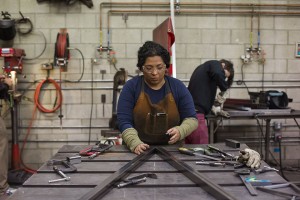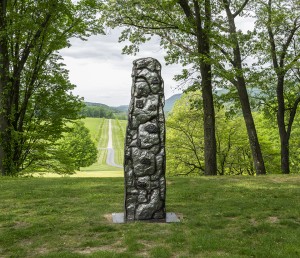CSUN Prof’s ‘Volcano That Left’ Recalls the Realities of the Immigrant Experience

“Ilopango, The Volcano that Left,” a sculpture by CSUN Central American and transborder studies Beatriz Cortez, currently on display through Nov. 13 at the Storm King Art Center in New York’s Hudson Valley. Photo by Jeffrey Jenkins.
When the COVID-19 pandemic hit, California State University, Northridge Central American and transborder studies professor Beatriz Cortez, an internationally recognized sculptor, wondered about other pandemics and their impact on the world.
Her research led her to the sixth century Tierra Blanca Joven eruption by the volcano Ilopango in her native El Salvador, one of the largest volcanic events recorded in history. Ash from the volcano blanketed the earth — its name means “Young White Earth” in English — and obliterated the sun for about 18 months, causing catastrophic damage and contributing to what is believed to be one of the world’s earliest recorded pandemics.
Scientists have found samples of ash from Tierra Blanca Joven — which came from the sacred underworld of the Maya of Mesoamerica — all over the world,” Cortez said. “The particles of the Mayan underworld were migrants crossing lands, rivers and oceans. I started to think about how everything migrates. How everything is in motion — the mountains, the land, matter. I wanted people to know that we are all part of a culture, a world, that is in motion.”

Beatriz Cortez working on a sculpture. Photo courtesy of Gina Clyne and Clockshop.
Cortez created three site-specific sculptures that consider the experience of migration through the lens of simultaneity, recalling multiple spatial and temporal realities that immigrants experience at once.
Her work is currently on display through Nov. 13 at the Storm King Art Center in New York’s Hudson Valley. The 500-acre outdoor museum features large-scale and site-specific commissions under an open sky. Storm King is the world’s leading museum for modern and contemporary outdoor sculpture.
Cortez said her Storm King exhibition examines “geologic, human and cosmic conditions to imagine other forms of existence that transcend static definition.”
She said she wanted to move beyond colonized notions of time and space. Instead, she infused her work with “indigenous knowledge, spirituality, philosophy and the cycles of the planet to reorient one’s understanding of the past and present, and to imagine an alternative future,” she said.
Cortez works in steel and fashions her sculptures by hand, creating undulating surfaces and organic forms that reflect the surrounding landscape of the Hudson Valley.
A central piece in the exhibition is “Ilopango, The Volcano that Left,” a reconstruction of the ancient volcano.
Cortez grew up swimming in Lake Ilopango, a crater left by the volcano’s eruption. “I never knew I was swimming above a volcano that transformed the earth and killed so many people,” she said.
With “Ilopango, The Volcano that Left,” Cortez said, she imagined how the eruption’s resulting migratory patterns reverberate across time and reinforced nature’s disregard for boundaries or borders.
“Lava flows under the volcanic range that unites my two homes, Los Angeles and El Salvador,” she said. “The underworld is not divided by these borders.”

“Stela Z, after Quiriguá, (Contrary Warrior).” Photo by Jeffrey Jenkins.
Another piece in the exhibition is “Stela Z, after Quiriguá, (Contrary Warrior),” which mirrors the form of a stela — a carved stone monolith — on the ancient Mayan site Quiriguá in present-day Guatemala. Welded-steel glyphs appear across its surface, charting a nonlinear chronology of the volcano’s journey throughout its creation and installation.
Her third piece is “Cosmic Mirror (The Sky Over New York)” — 11 boulders made of hammered steel nestled into the grass of the center’s Museum Hill like asteroids fallen to earth — a recreation of the constellation Orion, which sits in the night sky over El Salvador and the Hudson Valley. Like an ancient Olmec mosaic embedded in the ground whose true form can only be appreciated from the sky, “Cosmic Mirror” can only be fully comprehended from the height of a drone because of its scale.
True to its name, “Ilopango, The Volcano that Left” will leave Storm King in a performative departure in October. The sculpture will travel by boat up the Hudson River to EMPAC/the Curtis R. Priem Experimental Media and Performing Arts Center at Rensselaer Polytechnic Institute in Troy, New York, for the exhibition “Shifting Center.” The volcano’s journey will feature a weekend of collaborative programming along the river.
Cortez called the piece’s journey “a metaphor that allows you to see that everything is on the move.”
“Migration is not just related to humans and animals, everything on the planet is moving,” she said. “We just don’t realize or acknowledge it.”

 experience
experience